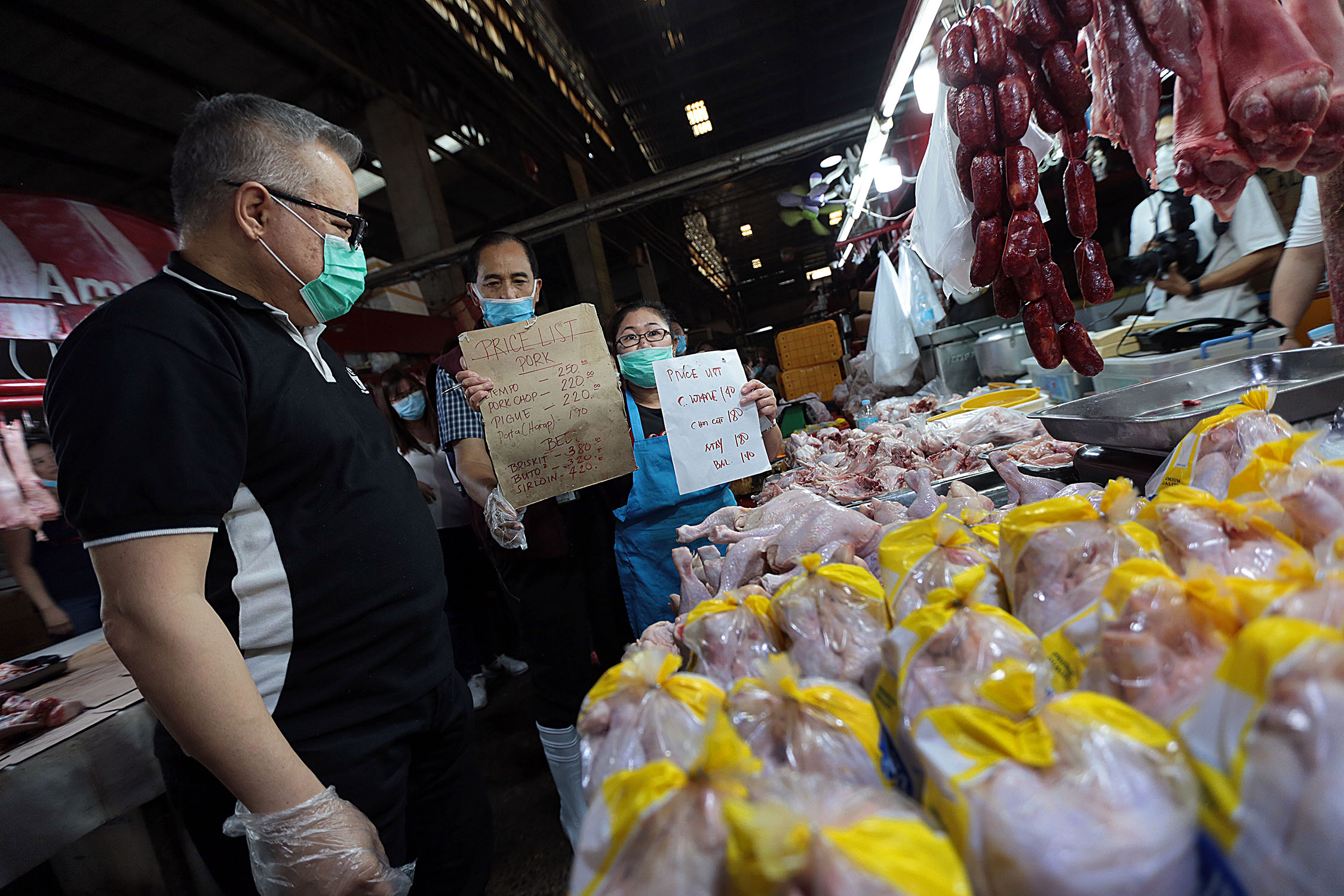
SUPPLY AND PRICE WATCH Trade Secretary Ramon Lopez and Agriculture Secretary William Dar inspect a market in Quezon City on March 26 to see whether basic goods are available and if their prices are right amid reports that food trucks are turned away at checkpoints on instructions from local governments enforcing their own quarantine rules. —GRIG C. MONTEGRANDE
Trade Secretary Ramon Lopez on Wednesday supported businessmen’s proposal for a gradual lifting of the Luzon lockdown from mid-April, which would see more people in essential industries go back to work.
President Duterte imposed the lockdown on the entire island of Luzon in mid-March, keeping half of the country’s population at home and temporarily shuttering most industries, to fight the new coronavirus, which has killed more than 42,000 people and sickened over 851,000 others across the globe since it emerged in China last December.
Called “enhanced community quarantine,” the lockdown ends at midnight of April 12.
‘More essential’ businesses
Speaking in a televised news conference on Wednesday, Lopez said he would recommend the phased lifting of the lockdown to the Inter-Agency Task Force on Emerging Infectious Diseases.
As proposed by the business community, the more essential businesses and their supply chains would be the first to return to operation to be followed gradually by other enterprises.
“[It would be] focusing on the more essential, the more basic businesses and their supply chains. This means even those that manufacture inputs for, let’s say food, essential products, hygienic products, medical products,” he said.
Also to be allowed to return to operation are the suppliers of parts, raw materials and packaging, as well as the agriculture sector, hardware stores and other services.
The businesses that would be allowed to reopen have to follow the “new norm,” which means workers entering their premises have to be scanned and checked for symptoms of COVID-19—the disease caused by the new coronavirus—and observe social distancing.
Consultation with business
Lopez noted that the businessmen themselves had warned against completely lifting the lockdown, and said he believed the people would also support phased lifting.
“I think even our countrymen are afraid of a total lifting, in the sense that crowded areas should not be encouraged, those with mass gatherings, such as concerts, big events, theaters. We should not expect that these would already return,” he said.
Last week, the interagency task force held an online consultation with some business leaders on how to deal with the coronavirus pandemic without leading to economic collapse.
A gradual lifting of the Luzon lockdown, resumption of manufacturing, and removal of the checkpoints were among the measures discussed.
Cabinet Secretary Karlo Nograles on Wednesday said the end of the quarantine would not mean that the coronavirus had been eliminated.
‘Far from over’
Nograles agreed with the World Health Organization that the coronavirus threat was “far from over,” especially since no vaccine for it had been developed.
“It’s true that it’s not over yet. But what we want to manage is to stop it from becoming widespread, and that all of those who would contract COVID-19 would be cared for and we would have more recoveries than deaths,” he said.
Nograles said claims on social media that the Luzon lockdown would be extended for 60 days were “fake news.”
But a technical working group is studying the possibility of extending the lockdown.
Health and labor groups said on Wednesday that the decision to lift the lockdown should be based not on economic and business interests but on whether the government had contained the spread of the coronavirus.
Too early
According to health advocate Minguita Padilla, it is still “too early” to consider lifting the lockdown, especially because the extent of the contagion remains unknown.
“We’re not ready because we didn’t have mass testing,” said Padilla, who earlier sought the use of rapid test kits to quickly determine if people had contracted the coronavirus.
“We need to do mass antibody testing before we can even start to gradually lift the quarantine. Germany and the [United States] have already recognized the value of this antibody testing, especially in gradually lifting the quarantine,” she said.
Anthony Leachon, a health reform advocate and former president of the Philippine College of Physicians, said the lockdown should be lifted only if the spread of the virus had stopped.
Indications that the contagion had ceased are “no new cases, zero deaths,” Leachon said.
The Filipino Nurses United said the current total number of infections, 2,311, was “not yet reflective of the true picture” of the epidemic in the country because the Department of Health (DOH) had only conducted “reactive testing” on people who had sought treatment in hospitals.
It said more cases could be found if more people under observation or monitoring and health workers were tested.
“Without free mass testing, we cannot see the accurate situation of COVID-19 in the country,” said Maristela Abenojar, the group’s president.
Labor group Sentro and the Trade Union Congress of the Philippines (TUCP) both expressed fear that the government would lift the lockdown on the recommendation of businessmen and not for a clear medical reason.
‘Invisible enemy’
“Our sufferings in the last two weeks may be put in vain if we would lift it and then find out that we have yet to contain the virus,” Sentro secretary general Josua Mata said.
“The DOH should [put] its foot down . . . because we are dealing with an invisible enemy that is not . . . comprehended by our business people. Business interest should be the least of our concern,” TUCP spokesperson Alan Tanjusay said.
Bayan Muna Rep. Carlos Zarate said the government must first make an honest report on the “real status” of the epidemic before talking about lifting or extending the lockdown.
Is the lockdown effective, Zarate asked. Without mass testing, he said, “we will just be shooting blind or shooting an invisible enemy in the dark.” —WITH REPORTS FROM ROY STEPHEN C. CANIVEL, JOVIC YEE AND DJ YAP

